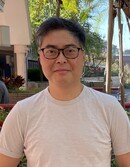
‘Astronomy is the most humbling science. Developing humility is a fundamental requirement to break paradigms and take humanity to the next level.’
Alfred AMRUTH, PhD student in the Department of Physics and the Laboratory for Space Research
Research foci: Dark Matter, Gravitational lensing, HPC simulations
Research foci: Dark Matter, Gravitational lensing, HPC simulations
Mr Alfred AMRUTH
Department of Physics, and
Laboratory for Space Research
Alfred AMRUTH, a PhD student in the Department of Physics, is dedicated to unravelling the mysteries of Dark Matter. Using gravitational lensing, a prediction of Einstein’s theory of general relativity where massive objects can bend the path of light, Amruth strives to shed light on this elusive substance that constitutes approximately 85% of the Universe’s mass.
Dark Matter cannot be explained by the Standard Model of Particle Physics and cannot be directly observed. Nevertheless, the existence of Dark Matter can be inferred from its gravitational effects on light from distant galaxies. While the conventional hypothesis proposes that Dark Matter is composed of ultramassive (super heavy) particles, Amruth's recent research, under the guidance of Professor Jeremy LIM from the Department of Physics, challenges this idea.
Collaborating with renowned astrophysicists, Amruth and his team analysed the positions and brightnesses of multiply-lensed images of background galaxies produced through gravitational lensing by individual foreground galaxies. Their research shows that models with ultralight Dark Matter particles closely match the observed phenomenon, challenging the belief that ultramassive particles are the primary Dark Matter candidates. They propose that Dark Matter may consist of ultralight particles behaving like waves during their cosmic journey.
Amruth's latest research paper, featuring his findings, was published as the cover article in the prestigious journal Nature Astronomy. In recognition of his remarkable discoveries, he was awarded the 2023 Hong Kong Young Scientist Award in the Physical/Mathematical Sciences by the Hong Kong Institution of Science.
On the Path to Unordinary Matter
Amruth's passion for science blossomed during his early days in Sri Lanka, where he was captivated by the enchanting night sky and celestial objects. This experience fuelled his fascination with the cosmos. He attributes his deep interest in science to his parents' unwavering support, as they provided him with books, including a popular series by National Geographic and the Discovery Channel. These books covered various subjects and sparked his curiosity about the Universe. ‘What sealed the deal was sci-fi novels which had a profound impact on my imagination, especially those written by Arthur C Clarke, the father of science-fiction, and world-renowned astronomer Carl Sagan’.
Astrophysics holds a special fascination for Amruth, as it describes the laws governing our Universe and everything within it. Moreover, the timeless question of whether we are alone in the Universe has captivated Amruth more than anything else. ‘The answer to this question has to be discovered through astrophysics and pushed me to pursue research in astronomy.’
Amruth is captivated by the enigmatic nature of Dark Matter, recognising its potential as a catalyst for advancing human civilisation and unlocking the possibilities of space exploration. Just as the discovery of fire and electricity propelled human civilisation forward, Dark Matter has the potential to be the next milestone for humanity.
Amruth is actively collaborating worldwide to study wave-like Dark Matter in galaxies. His work has gained significant interest among scientists and is paving the way for exciting new scientific exploration. He credits his development as a scientist to his invaluable mentor, Professor Jeremy LIM, and the unwavering support of his collaborators, colleagues, and girlfriend.
Amruth's career goal remains unchanged from his childhood: to gain a comprehensive understanding of the Universe. He is dedicated to continuing his research and teaching to inspire curiosity and passion in younger generations for as long as possible.
He humorously adds, ‘Answering this question of how the universe works would be much quicker if we were fortunate enough to discover intelligent extraterrestrial life willing to assist us in our quest for knowledge!’
The study of crinkles in spacetimeLearn more about Amruth's research
Supervisor: Professor Jeremy LIM, Associate Professor of the Department of Physics |
| < Previous | Next > |


